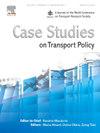Comparing perception-based methods and traditional level of service for urban infrastructure evaluation: Bogotá’s road diet case study
IF 2.4
Q3 TRANSPORTATION
引用次数: 0
Abstract
Road diets have become a common practice in urban planning to enhance safety and sustainability by reallocating traffic lanes for underserved infrastructure. This study evaluates a road diet along a major corridor in Bogotá, Colombia, using both Level of Service (LOS) and perception-based methods to analyze their effectiveness and complementarity for assessing urban local interventions. We collected geometric and operational data for LOS calculations and we administered a random intercept survey to assess user perceptions, before and after implementation. By comparing outcomes from perceptual evaluations and traditional LOS methods in the case study, we found that both methodologies indicated overall improvements in service for pedestrians and bicyclists post-intervention. This study highlights the efficacy of perception-based methods in capturing nuanced user experiences and preferences, providing valuable insights for urban planners and policymakers.
求助全文
约1分钟内获得全文
求助全文

 求助内容:
求助内容: 应助结果提醒方式:
应助结果提醒方式:


